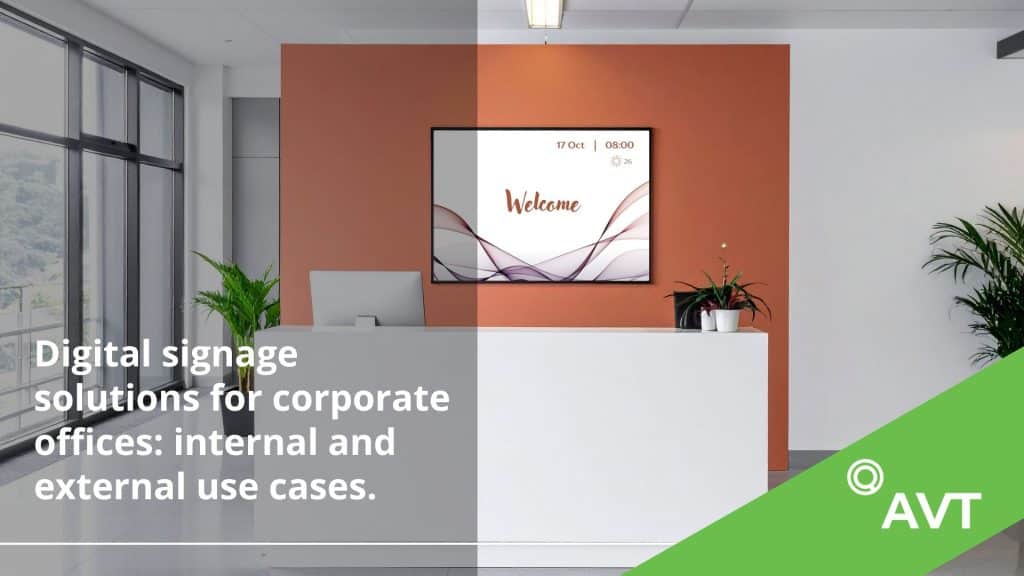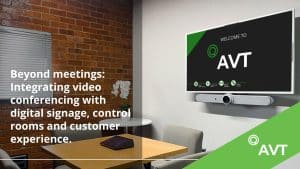Digital signage has become one of the most effective ways for businesses to communicate messages in a simple and engaging way. While it is widely used in retail and hospitality, digital signage solutions are just as valuable inside corporate environments. Offices today need better internal communication, faster decision-making, and stronger engagement. Digital display solutions help achieve that by delivering the right message to the right people at the right time.
What is Corporate Digital Signage
Corporate digital signage refers to using digital screens to share information, announcements, dashboards, company news, and branded content within an office environment. These screens can be placed in reception areas, meeting rooms, open-plan offices, manufacturing floors, cafeterias or executive spaces.
Modern digital signage systems are powered by cloud-based software that allows teams to control content remotely and schedule updates in real time. This removes the delays and costs associated with printed posters or static boards.
Why Businesses Are Adopting Digital Signage
Companies need faster communication channels, especially in modern hybrid or multi-location work environments. Emails often get ignored. Noticeboards go unnoticed. Meetings take time. Digital signage cuts through the noise by delivering short and visual content that people actually see.
Some of the key reasons businesses choose digital signage include:
- Stronger internal communication
- Consistent branding across multiple offices
- Real-time updates and alerts
- Employee engagement
- Streamlined visitor management
- Improved productivity through shared information
Digital signage is not just about screens. It is a communication tool that improves workplace transparency and performance.
Internal Use Cases for Digital Signage in Offices
1. Employee Communication Screens
Internal communication remains a challenge for many companies. Employees often feel out of the loop or disconnected from leadership. Digital signage screens placed in common areas can display:
- Company announcements
- Project updates
- Product releases
- HR notices
- Internal event reminders
- News from leadership
This ensures employees do not miss important information.
2. KPI and Performance Dashboards
Data-driven workplaces are becoming more popular. Displaying real-time dashboards allows teams to track progress toward goals. Some examples include:
- Sales performance
- Customer service metrics
- Project milestones
- Production efficiency
- SLA or uptime tracking
These visual dashboards help teams stay aligned and motivated.
3. Meeting Room Display Systems
Digital signage systems integrate well with meeting room calendars like Outlook or Google Calendar. Businesses use them to:
- Show room bookings
- Reduce double bookings
- Share video conferencing links
- Display meeting reminders
- Simplify room scheduling
This avoids confusion and saves time across large offices.
4. Corporate Culture and Engagement
Digital signage can help build a stronger company culture by celebrating employee milestones and promoting engagement. You can display:
- Employee birthdays
- Awards and recognition
- Team wins
- Employee of the month
- Internal campaigns
Small gestures go a long way in boosting morale.
5. Safety and Compliance Communication
In industries where compliance is critical, digital signage provides quick updates and standard operating instructions. You can show:
- Health and safety rules
- Compliance policies
- Emergency alerts
- Evacuation procedures
- Visitor safety information
Digital safety boards are easier to manage than traditional signage and help reduce workplace risk.
External Use Cases in Corporate Environments
1. Reception and Welcome Displays
Reception digital screens create a strong first impression. A professional display can show:
- Welcome messages
- Branded videos
- Product visuals
- Highlighted company awards
- Visitor information
This builds trust with clients and visitors before a meeting even begins.
2. Wayfinding and Navigation
Digital wayfinding signage helps visitors move around office buildings with ease. It can guide people to:
- Meeting rooms
- Departments
- Conference halls
- Restrooms
- Cafeterias
- Parking areas
It is especially useful for large campuses or shared office parks.
3. Digital Directories
Instead of outdated printed directories, businesses now use interactive digital directories. Visitors can search for:
- Employees
- Contact extensions
- Departments
- Meeting rooms
This speeds up communication and improves visitor experience.
4. Corporate Branding Displays
Businesses use external-facing digital displays to reinforce brand identity and share their story. These can include:
- Company history
- Mission and values
- Client testimonials
- Corporate social responsibility videos
- Product demo videos
A strong and consistent brand presence builds credibility.
Benefits of Digital Signage for Business Environments
Digital signage solutions offer real value to corporate offices because they improve communication and help teams stay informed. One of the biggest benefits is centralised content control. Instead of sending emails or printing notices, content can be updated instantly across multiple screens from one dashboard. This makes it easier to keep staff informed about company updates, safety messages, meetings, or important deadlines.
Another clear advantage is real-time communication. When something changes, such as a policy update or emergency alert, businesses can push that message out immediately, which helps speed up decisions and responses across the organisation.
Cost efficiency is another strong reason companies move to digital display solutions. Traditional posters and printed materials cost money and time to produce every time there is a change. Digital signage removes that cost and allows for easy updates whenever needed. It is also a flexible solution. Businesses can use screens for a range of purposes including branding, internal dashboards, or visitor information.
The system grows with your business because it is easy to add more screens or locations as needed. Most importantly, digital signage improves engagement. People are more likely to notice and remember visual screen content compared to email or static noticeboards. This makes digital signage a powerful tool for both internal and external communication in any corporate space.
Return on Investment of Digital Signage in Corporate Offices
The return on investment from digital signage goes beyond the communication benefits already discussed. Businesses that adopt digital signage often see measurable gains in productivity, awareness and operational efficiency.
Internal teams spend less time sending follow-up emails or repeating information because messages reach employees clearly and instantly. Meeting room screens reduce scheduling conflicts, which improves time management. Safety and compliance reminders lower the risk of workplace incidents, which reduces downtime and potential penalties.
Digital signage also improves employee engagement by keeping staff connected to company goals and priorities, which can boost retention and performance. When companies replace printed posters and static signage with digital screens, they remove ongoing printing costs and delays. Over time, the combination of time saved, reduced printing expenses, improved communication clarity and better decision-making delivers a strong and sustainable return on investment.
Types of Digital Signage Screens Used in Offices
There are several types of digital signage screens that businesses can use depending on how they want to communicate.
LCD screens are the most common type found in office environments. They are ideal for reception areas, open office spaces and hallways where internal communication content like announcements or welcome messages is displayed. They are cost-effective and offer good image quality, which makes them suitable for general information sharing.
LED video walls are another type used mainly in large corporate lobbies or executive areas. These screens create a strong visual impact and are often used for brand storytelling, company timelines or displaying dynamic content that impresses visitors.
Businesses that want interactive communication can use touch screens. These are often installed as digital directories in reception areas where visitors can search for departments, people, or meeting rooms. Meeting room panels are also part of digital signage systems. These small interactive screens are mounted outside meeting rooms and display booking schedules in real time.
Outdoor LED screens are used at office park entrances or building exteriors to display corporate messaging or directions. Each screen type has a specific purpose, and selecting the right display depends on the location, audience and communication goal.
How to Plan Your Digital Signage Strategy
A successful rollout starts with planning. Here are some steps to follow:
- Define objectives
Decide whether your goal is improved communication, branding, metrics tracking, or safety. - Choose screen locations
Pick high-traffic areas where content will be seen. - Plan content
Use a schedule to keep displays active with fresh content. - Select software
Choose a content management system that is simple and scalable. - Work with a reliable provider
Partner with a digital signage company that offers support, installation, and training.
How AVT Supports Corporate Digital Signage Solutions
AVT provides complete digital signage solutions for businesses in South Africa. Our team has extensive experience in delivering display networks that are practical, easy to manage and tailored to real communication needs inside corporate environments. We supply and install commercial-grade digital display solutions including LCD screens, LED walls and interactive touch panels. We also offers content management systems that allow teams to control multiple screens from one place, schedule content and update messaging in real time.
Our solutions integrate with corporate tools like Microsoft 365 and Google Workspace, which makes meeting room displays and internal communication screens simple to manage. We also provide local installation, support and maintenance services, which means your entire digital signage system stays reliable and effective long after it is installed. Whether you need a small office setup or a multi-branch signage network, we offers scalable digital signage for business communication that grows with your organisation.
Final Thoughts
Digital signage solutions are no longer nice to have. They are essential tools for modern workplace communication. They help businesses share key messages, engage employees, improve productivity, and create a better visitor experience. Whether it is an internal dashboard or a reception display, corporate digital signage delivers clear value.
If your business wants to improve communication and make information easier to access, digital display solutions are a smart investment. Start small and scale your network over time. The key to success is partnering with a reliable provider like AVT, who understands your business needs and offers long-term support to ensure your signage delivers lasting impact.





